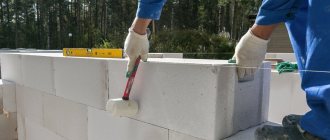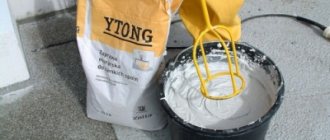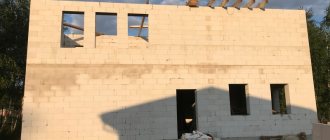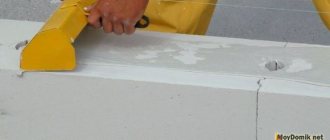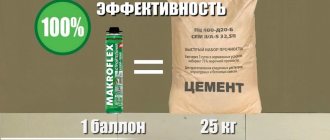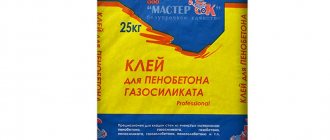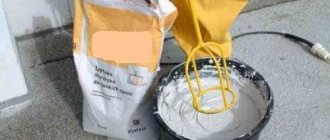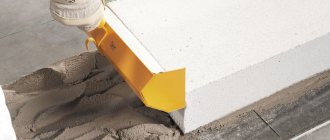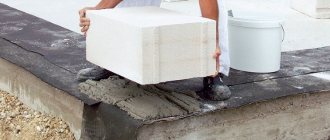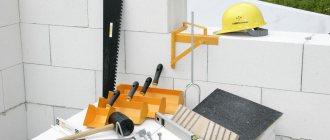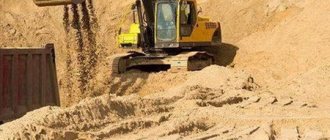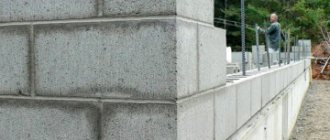Houses built from aerated concrete are characterized by reliability and durability. The strength and other operational parameters of the building largely depend not only on the quality of the blocks, but also on what kind of glue and in what quantity was used for the masonry. The choice of mixtures for joining aerated concrete products today is huge, but a good product is not cheap.
Agree, it is better to know in advance how much glue will be needed for the construction of an aerated concrete building. Then you will not have problems due to the fact that you purchased more or less mixture than you need. Determining the glue consumption for aerated concrete blocks per 1m3 is actually not difficult. You need to know some features and nuances.
In this article we will tell you why it is so important to be able to calculate the optimal amount of glue; we will provide a formula by which you can easily understand how many bags of the mixture you need. We will also list and consider the factors on which the amount of adhesive consumption depends. We will give advice on choosing and preparing glue for laying gas blocks.
How much glue will you need?
The aerated concrete adhesive consumption per 1 m3 is approximately 23-26 kg, depending on a number of factors, or 1.5-1.7 kg per 1 m2.
Glue costs will be affected by:
- glue quality;
- recommendations for use stated by the manufacturer;
- temperature conditions (base and solution must be at least +50 C);
- condition of the blocks: with defects or even;
- weather;
- using the necessary tools (carriage or trowel-bucket), which speeds up the laying process, minimizes glue consumption and reduces the cost of work;
- number of reinforced layers;
- qualifications of workers: masons, as a rule, make 0.5 cm seams and few people use the 0.3 cm standard.
Which adhesive for foam blocks is better
The range of mixtures on the construction market is quite large; the task of choosing can be simplified if you take into account the following recommendations:
- low price often means low quality, but even the most expensive mixtures do not always live up to expectations;
- materials from reliable manufacturers should be considered;
- calculation of a sufficient amount of dry mixture is done with a reserve: experts advise purchasing 1 package more;
- when choosing, take into account weather conditions and the time of year: if the work is planned to be carried out in winter, only frost-resistant glue should be considered as an option.
Volma
Volma brand glue.
This variety is suitable for laying silicate, gas and foam blocks. The average cost of a package (25 kg) is 177 rubles. This composition can be used indoors and outdoors.
Its main advantage is its relatively low consumption (1.4 kg per 1 m²). The position of the blocks must be quickly adjusted - no more than 10 minutes are allotted for this.
This brand of glue can be used to create a seam with a thickness of 2 to 5 mm. When mixing the dry mixture, take into account the ratio of this material and water, respectively: 1 kg and 0.21-0.23 l. The bending strength is 5 MPa. Recommended temperature range: +5…+30°С. Frost resistance index - F35. The finished solution retains its properties for 90 minutes at a temperature of +15°C.
Adhesive foam Titan
Available in aerosol form (balloon) Volume - 870 ml. Average price - 480 rubles. This variety is intended for laying gas and foam blocks. This is a polyurethane based adhesive. Characterized by high adhesion and long service life. The advantage is the absence of waste, since the mixture is applied using a construction gun in an amount sufficient to attach the blocks. The adhesive can be used at low temperatures.
Titan adhesive foam is available in aerosol form.
It is important to prepare the surface before applying Titanium polyurethane adhesive. Otherwise, adhesion will decrease
To be able to work with this mixture, the cylinder should be kept warm: it is immersed in warm water for a while or left in a heated room for 1 day. Then the container is shaken several times. You can open it only after installing it in the gun. On the outside, the foam layer is protected with a thin layer of cement mortar.
Knauf
This type of mixture can be used for laying blocks of different types, including foam blocks. Its average price is 160 rubles. pf packaging (25 kg). This composition contains polymer additives that increase the strength of the material. The advantage is the low consumption of 18 kg. The amount of water for preparing the mixture using 1 kg of dry material is no more than 0.2 liters.
To work with the adhesive, it is recommended to use a grater, usually a trowel. The compressive strength of the material is 2.5 MPa. This type of mixture is used to create seams of significant thickness - up to 12 mm.
Ivsil Block
Ivsil Block is a universal type of material.
This is a universal type of material, suitable for fastening different types of blocks and foam blocks as well. The average cost of a 25 kg package is 215 rubles. The composition includes cement, polymer and water-retaining additives, fine sand. The material is suitable for indoor and outdoor use. It can be used to create a 2 mm thick seam.
This reduces the risk of the structure freezing through the joints. The advantage is the low material consumption. In addition, you can work with the finished mixture much longer than with other types of solutions - up to 4 hours.
Tile adhesive
If it was not possible to choose the most suitable mixture for working in harsh conditions (in the cold), it is permissible to purchase tile adhesive that can withstand low temperatures. However, this option can only be used if the blocks are fairly even. The permissible deviation is no more than 1.5 mm in height. The recommended size of foam blocks for masonry is up to 100 mm on the longest side. You should choose tile adhesive for installing such products if you have experience in performing construction work.
Consumption of aerated concrete adhesive per 1 m3 in kilograms
| With a block thickness (cm) and a density of 300-400 kg\m3 | Consumption in kg\per cubic meter | Consumption kg\m2 |
| 10 | 19,3-19,4 | 1,9-2,0 |
| 15 | 19,9-21,0 | 2,9-3,0 |
| 20 | 16,4-16,8 | 3,3-3,5 |
| 25 | 15,9-16,2 | 4,0-4,4 |
| 30 | 15,5-15,8 | 4,6-5,2 |
| 37,5 | 15,1-15,4 | 5,7-6,0 |
| 40 | 14,9-15,1 | 6,0-6,3 |
How to check which glue is best for claque? It is necessary to purchase a kilogram of various compositions, prepare them according to the recipe and allow them to completely harden on the glued gas blocks (two are enough). After a day, you need to try to break the seam and assess the location of the break:
- the fracture coincides with the seam - glue should not be used;
- the fault partially touches the seam - the quality is in doubt;
- the seam remained undamaged and the gas block itself was damaged - excellent quality, this glue can be chosen for any work.
Another way to check is the weight of the glue after hardening. You need to fill the same amount of glue into several containers of the same size. A day later, weigh. Preference should be given to the solution whose weight is less. This indicates that a significant part of the moisture has gone and the mixture will be strong and no less thermally conductive.
Of course, testing glue is a troublesome and expensive task, but if large-scale construction is planned, you should not refuse to diagnose the declared parameters.
Advantages of aerated concrete adhesive:
- material consumption is 6 times lower, and the cost, unlike cement-concrete mortar, is only 1.5-2 times higher, so the savings are obvious;
- the use of a fine-grained mixture helps to avoid the formation of “cold bridges”;
- a thin layer of adhesive base can effectively emphasize the evenness of gas blocks;
- the solution can be used at any time as putty;
- the glue hardens without shrinking;
- the composition of the solution always remains homogeneous with regular stirring, which increases the adhesive strength;
- the plasticity of the material practically eliminates heat loss;
- thin-layer masonry of aerated blocks is much stronger and more durable than standard cement-sand mortars.
How to determine the required number of aerated concrete blocks
What you need to know to calculate aerated concrete blocks
There are many advantages in favor of this material. Among them are a simple installation method, low weight, good sound and thermal insulation. But before proceeding with installation, it is necessary to draw up a project and a preliminary cost estimate. In order for construction to be profitable from an economic point of view, you need to decide on the method of masonry, its thickness, and then the amount of building and consumable materials. In order not to resort to paid services of designers and not to waste time on complex calculations, use an online calculator. The program is designed specifically for builders who want to minimize their hassle and material costs. The calculator has a simple interface and a small list of parameters. This is enough to quickly and accurately find out:
- total length, area and height of the walls;
- area of windows and doors;
- density of the base material;
- rows of aerated concrete;
- the number and volume of gas blocks, based on their size;
- amount of glue;
- the weight of the walls without jumpers, connectors and armored belts.
To obtain all of the above data in literally one second, the user will need to enter the requested parameters: the total length of the walls, their average height, the sizes of windows and doors. The parameters of the gas block are also important: density, length, height and width.
Recommendations
If everything is simple with the dimensions and density of aerated concrete blocks (you can find them on the packaging, on the Internet or in a store from a consultant), then not everyone can determine other parameters. For example, the total length of the walls is calculated in the same way as the perimeter. That is, if you plan to build a house 15x9 m, you need 15+15+9+9. The result is 48, which must be entered in the “Total length of aerated concrete walls” cell.
The average height in a private house may vary depending on the wishes of the developer. But the standard figure is 2.7 m. As for openings, determining their area is important for your own savings.
- If the expected dimensions of the front door are 80x200 cm, you need to determine their square footage. Let's multiply these indicators and get 1.6 m².
- If there are supposed to be 5 window openings with the same dimensions of 1.2 m x 1.8 m. Let's calculate them: 1.2 * 1.8 = 2.1. 2.1 * 5 = 10.5 m²
- To find out the total square footage, simply add the area of all doors and windows. 10.5 * 1.6 = 16.8 m².
We enter this figure in the third cell “Total area of window and door openings.” After all the fields are filled in, you can click “Calculate” and get all the starting data on the basis of which you can make purchases and plan the budget for upcoming work.
How are calculations carried out?
The work of this program is based on building codes for single- and multi-story buildings. According to them, the minimum thickness of columns and partitions made of autoclaved aerated concrete for load-bearing walls is 60 cm, for self-supporting walls - 30 cm. Note that the result is advisory in nature.
The formula is applied V = (L * H - Spr) * 1.05 * V, in which:
- L – wall perimeter;
- H – wall height;
- Spr – area of openings for doors and windows;
- 1.05 – coefficient for pruning with a margin of 5%;
- B – density of gas blocks;
- V – volume of aerated concrete.
Calculating the optimal number of blocks depends on a number of other factors. The resulting result is mainly influenced by the number of storeys of the house. It is decisive when calculating height. Calculation becomes difficult if you plan to make an attic with a non-standard roof or make window openings non-standard in their configuration. In this case, you should turn to specialists for design, and use the online calculator as an auxiliary one.
The thickness of the wall material also matters. How wide you need to make aerated block walls primarily depends on the prevailing weather conditions. In a temperate climate with relatively warm winters, blocks 40 cm thick (if laid in one row with a cement joint) will be sufficient for comfortable thermal insulation. Each climate zone has its own standards, regulated by state standards:
- in houses for permanent residence, the optimal wall thickness is 60 cm;
- self-supporting walls (external, enclosing) – 30 cm;
- partitions – 20 cm.
Sometimes the preferred masonry thickness also depends on the brand of aerated concrete. There are many varieties of them on the market of modern building materials. For example, if construction is planned in regions with harsh winters, you can purchase a gas block that combines a two- or even three-layer system.
In terms of size, 60x40x25 blocks are recommended for large multi-story structures. If partitions are to be erected, these parameters may be smaller.
What to pay attention to
Aerated concrete is a material, when working with which it is necessary to take into account the geometry of the block. Otherwise, it will not be possible to achieve ideal evenness of the walls, and you will have to spend time and effort on additional leveling work. For this purpose, the gas block is laid not on cement mortar, but on glue.
Each type of material has its own density class. It is worth taking note: after construction from D400 and D500, the building will not have to be insulated from the facade. If you are planning a multi-story building or a one-story building with a monolithic frame structure, you can choose class D600. It is suitable for buildings with ventilated facades. Experts assure that a properly designed and laid wall is always enough to keep you warm in winter and cool in summer.
Let's consider a budget option for block masonry and a more expensive one. The first involves the construction of a single-layer wall from aerated concrete block D400 without insulation. A design made from a single-layer aerated block + insulation will cost more. A ventilated facade is laid on top of the thermal insulation. Although this is more expensive, the obvious advantage is high thermal conductivity. In such a house the heat will linger much longer.
How to prepare and use glue
To prepare the glue, you will need a construction mixer or drill with a suitable attachment. Dry concentrate is added to pre-drawn water (temperature up to +600 C). After thorough mixing, the solution is allowed to stand for 15 minutes and whisked again for about a minute. If the masonry will be carried out during the cold season, it is better to give preference to special adhesives with anti-frost additives and store the mixtures at a temperature not lower than +50 C. In hot weather, the solution is suitable for work up to 120 minutes, in cold weather - 25-30 minutes.
When using an adhesive composition, it must be taken into account that the solution requires stirring every 15-20 minutes to maintain the homogeneity of its consistency.
It is undesirable to carry out work in strong winds or precipitation (rain, snow). This way the solution will “gain moisture”, which will affect its adhesive ability.
Before using the adhesive base directly, it is worth carrying out a test bonding to determine what thickness of the seam will be optimal.
Approximately, the indicators will be as follows: for 1 kg of ordinary glue 0.3 liters of water; for the winter mixture you will need 0.2 liters. At the same time, the time spent on laying and correcting blocks is reduced to the required minimum.
Glue consumption for aerated concrete per 1 m3
When building a new home, people are increasingly choosing a material such as aerated concrete. It is often placed on dry adhesive mixtures, rather than on a regular solution. Because the glue has lower thermal conductivity, thereby allowing for better heat retention inside the house. To calculate the required amount of adhesive material for construction, you need to know the aerated concrete adhesive consumption per 1 m³.
Preparation of working solution
Before you start work, you need to study the instructions on the packaging and strictly adhere not only to the ratio of the adhesive composition to the volume of liquid, but also to the appropriate temperature regime.
There are also general requirements for the work:
- a container must be prepared in advance where the solution will be mixed, and a drill with a construction mixer;
- the ratio of dry concentrate to water is usually 1 to 0.22 (about 220 ml of water is needed per 1 kg of powder);
- the water temperature must correspond to the instructions, but not lower than 15-20 degrees;
- the mixed solution must be homogeneous.
To obtain high quality adhesive components, it is recommended to mix everything until smooth, leave the mixture for 10-15 minutes, and then mix thoroughly again with a mixer. The prepared mixture should be used within the next 3-4 hours, unless otherwise indicated in the instructions for use. Water cannot be added to a ready-made solution.
general information
The structure of aerated concrete material is very porous. For this reason, the mortar on which the blocks will be laid must have high astringent properties. Special ready-made mixtures fully satisfy this requirement.
The main materials from which aerated block adhesive is made:
- cement grade 500 and higher;
- fine sand;
- various additives (for moisture resistance, increasing strength, viscosity, etc.).
Compared to cement-sand mortar, the price of ready-made mixtures is much higher. But thanks to the low cost of adhesive bases, the cost is almost equal, and the quality of the masonry increases.
Advantages of ready-made mixtures:
- high plasticity;
- water-repellent properties;
- do not collapse from severe frosts;
- hardens very quickly (no need to wait before laying the next row).
Using glue you can achieve high adhesion of aerated concrete blocks. And also the seams will not crack at high humidity levels.
The types of glue used in construction vary depending on the season. If work takes place in winter, then frost-resistant mixtures must be used. They contain special plasticizers that allow aerated concrete to be laid at low temperatures. This glue is prepared in warm water (not lower than 35 degrees). It should be taken outside immediately before application. You need to consume the finished material as quickly as possible. This should take no more than five minutes.
You can significantly reduce the consumption of glue for gas silicate blocks by 1 m³ if you use a special tool. This will also help reduce laying time. Required tool:
- cement bucket;
- rubber mallet;
- high carbon steel hacksaw;
- mixer (required);
- corner 90 degrees;
- grater or sandpaper;
- metal grater.
The aerated concrete block (sibit) must be dry. Before applying the glue, it should not be wetted, as when using cement-sand mortar. The block also needs to be cleaned of dirt, if any.
Tips for saving glue
If you use the following recommendations, you will be able to use glue most economically.
Using a special ladle, square, rubber hammer, grater with skin, or saw will help make the work easier. At the same time, it will be possible to make consumption in minimal quantities.
It is best to apply the glue using a special spatula or spatula. Because of this, the mixture will be applied in an even layer and at the required thickness.
Before starting work, you need to check the blocks and, if necessary, rid them of dirt. An important task in the preparatory work is drying the material for construction.
Dependence of material consumption
The packages usually indicate how much glue is used for 1 cubic meter of aerated concrete. When construction involves large volumes of work, the amount of material spent can significantly exceed the standards stated by the manufacturer. The difference can be very impressive in the consumption of aerated concrete adhesive per 1 m3. But there are also opposite situations. When calculating the required amount of mixture, several factors must be taken into account:
- Properties of the adhesive composition. The more fractional impurities in the mixture, the higher the need for a large layer. If the composition is based on adhesives and binding substances, then you can get by with a minimal layer (2-3 mm).
- Layer qualification. Proper technique for using bonding material greatly influences the flow rate. Beginners often spend too much solution when laying aerated concrete blocks.
- The presence of a layer of reinforcement. If a reinforcing layer is provided in a gas-block wall, then the consumption of the mixture will greatly increase.
- Rejection of gas blocks. If you use a solution with a large amount of binding substances and the correct installation technique, and the gas block has defects, then the consumption can increase significantly.
Taking these criteria into account, you can roughly calculate how much glue consumption for aerated concrete blocks should be included in the estimate. This will also help you avoid unnecessary expenses.
Masonry adhesive Kreps
All mixtures, at least slightly, differ from each other in their composition. This largely determines the cost of material during the construction of a house. “Kreps” is one of the most economical mixtures for laying aerated blocks. It contains fine sand, high-quality cement and various plasticizers that help better bind aerated concrete blocks.
If all standards are observed, the average thickness of the adhesive layer is 2 mm. If you use a minimum thickness of joints, you can minimize the risk of cracks. One bag of dry mixture is consumed per cubic meter of aerated concrete blocks.
You can calculate expenses not by volume, but by area. In this case, the consumption will be 1.5−1.6 kg per 1 m². Any physical impact is not terrible even with a thin layer of seams. Low temperatures and mechanical loads do not affect the final result.
Insi-Block mixture consumption
This manufacturer produces not only ready-made mixtures for masonry, but also directly aerated concrete blocks. When making glue, mineral additives are also added to the standard set of materials. This allows you to increase the threshold of strength and adhesion. But high quality properties can only be achieved if the required layer specified by the manufacturer is applied (thickness from 2 to 4 mm). Dry material consumption is 28 kg per cubic meter of aerated concrete blocks.
Such expenses were calculated based on a layer of 2 mm. If the thickness of the seam is increased, then the consumption, accordingly, will also be increased. This mixture comes to the market in 25 kg bags, so, for example, for 10 cubic meters of blocks you need to buy 11-12 bags of dry glue. One bag requires 5-5.5 liters of water. If you follow this proportion, the finished solution can be used within three hours .
Masonry mixture Real
This adhesive for masonry aerated concrete mixtures is quite famous among builders. Made from cement. Frost resistance and water resistance are at an average level. If work takes place in the cold season, then you cannot do without frost-resistant additives. The main advantage is the ability to place blocks on a very thin layer of glue, which allows you to save a lot on material. This is achieved thanks to a high level of plasticity and water-repellent ability (adhesion).
"Real" allows you to lay the aerated block on a layer of 1 mm. With such a seam, the consumption per cubic meter of block is 21 kg of dry mixture. This glue is one of the most economical on the market at the moment. The quality of the masonry does not deteriorate due to this. This also allows you to save on plaster when facing walls. The average layer thickness decreases from 8 mm to 5 mm.
Popular adhesive mixtures
When deciding which adhesive to choose for gas silicate blocks, it is worth studying the features of current offers.
Aerostone is a product of the Dmitrovsky Aerated Concrete Products Plant. Cement-based mixture with polymer additives. The product is presented in winter and summer versions.
Aerostone adhesive for gas silicate blocks
- Thermocube is an adhesive mixture for interior and exterior work, intended for thin-seam masonry of walls and partitions based on grooved and grooveless gas silicate blocks. The building material is distinguished by high qualities of strength, frost resistance and ductility. Provides economical consumption.
- Ilmax2200 – adhesive for laying blocks of porous concrete, including gas silicate, foam concrete, expanded clay concrete slabs and other wall panels. Frost resistance of the product is 75 cycles, operating temperatures range from -30°C to +70°C, temperatures for block laying work range from +5°C to +25°C. The prepared solution is used within 4 hours.
- Ceresit is perhaps one of the most popular construction brands, a supplier of high-quality mixtures for various categories of work. Ceresit CT21 adhesive is made on the basis of cement; mineral fillers and organic modifiers are included as additives. The product is used for thin-layer masonry of gas silicate wall blocks and other types of cellular concrete panels.
- Knauf - a gypsum-based adhesive composition provides strong adhesion to the surface. The products of this manufacturer are in demand due to their competitive quality, although they are sold in the expensive segment. Knauf Perlfix adhesive mixtures with an environmentally friendly composition are easy to apply and allow you to quickly level the blocks.
- IVSILBlock - the mixture is used for laying grooved and conventional blocks made of porous concrete. Polymer inclusions increase adhesion, and modifying additives impart plasticity to the binder base. The position of the blocks when laying with this solution can be adjusted within 25 minutes, which is considered a competitive advantage of the material.
- Aeroc is a product of a company producing cellular concrete from St. Petersburg and occupies a leading position in the domestic market of construction resources.
- "Zabudova" is one of the best adhesives for gas silicate blocks. The products are valued for their high performance when used in winter at a relatively low cost. The composition performs well at ambient temperatures down to -15°C, is easy to mix and apply, consumption is more than economical, seams are not subject to atmospheric influences.
- Unic Uniblock is a brand that produces high-quality gas silicate blocks and masonry mixtures; the products are sold in the middle segment.
- Bonolit - a dry concentrate for gluing gas silicate deserves attention due to its absolutely environmentally friendly composition, has no toxic impurities, and is in demand for both external and internal work.
Adhesive for gas silicate blocks Bonolit
- “Prestige” - the mixture is used for laying all types of porous concrete blocks; it is characterized by high frost resistance due to its composition with modifiers.
- “Pobedit” is a multicomponent cement-based adhesive with quartz sand and polymers; its composition is completely identical to aerated concrete blocks and is capable of adhering to the surface with the highest quality, forming a monolithic composition.
- "EK Chemical" - the mixture is intended for thick-layer masonry, suitable for work in any season. In addition to constructing walls and partitions from blocks based on cellular concrete, the composition can be used when installing ceramic tiles and leveling wall surfaces.
Optimal adhesive consumption for aerated concrete
It is impossible to calculate the average consumption of mixtures, since it is different in each individual situation. At such moments, builders are faced with a completely different question: will the increased waste of glue be justified, or is it better to go the other way and reduce consumption to a minimum, which will reduce cold bridges?
Manufacturers are trying to make glue that allows thin seams to be made. This is due to the fact that a thick layer does not make the masonry stronger, but the thermal insulation of the house deteriorates (aerated concrete retains heat much better than hardened glue). Thin seams allow for maximum heat retention and are also easier to make straight joints.
The approximate average consumption of adhesive for masonry aerated concrete can be taken as 30 kg of dry mixture. If there are too large deviations from this value, this may mean that the wrong masonry technology has been chosen or the gas blocks have serious deviations.
How to calculate glue consumption for aerated concrete blocks
Houses made from aerated concrete blocks are distinguished by increased heat and sound insulation characteristics, combined with an affordable price. Their disadvantage is increased hygroscopicity. It can be reduced if the blocks are laid on special compounds, calculating the adhesive consumption for aerated concrete.
Consumption of adhesive composition when laying aerated concrete blocks
There are certain requirements and recommendations for calculating the volume for masonry. Calculation of adhesive for aerated concrete can be done using a special calculator. To obtain a perfectly smooth and thin seam, it is necessary to choose the right not only glue, but also the amount of material.
Regardless of the manufacturer and type of adhesive composition, the adhesive consumption for aerated concrete blocks, calculated using a calculator, will be approximately identical. You can do the calculation yourself, knowing the parameters - the thickness of the external and internal walls. The density of concrete is different, the thermal insulation properties are different, and accordingly, the thickness of the walls depends on the purpose and brand of concrete.
The consumption of adhesive for aerated concrete blocks per m3 also depends on the size of the blocks themselves, which are used to build the wall. According to general recommendations, consumption per 1 cubic meter. is 25-30 kg of composition. This is a standard package of dry mixture. The norm can be increased to 38 kg, as practice shows, this is a natural situation. Consumption increases if reinforcement is laid between the blocks.
If we consider the consumption of adhesive for aerated concrete blocks per 1 m2 on a flat surface, then approximately 1.5 kg of material is needed. It is worth understanding that the calculations are all approximate; in real conditions, the figures may differ significantly. This is due to various factors:
- Tools used;
- Type of blocks, their geometric features;
- Working conditions;
- Quality of material;
- Master's qualification.
For your information! You can purchase additional glue from different batches, since the mixture is almost identical.
The amount of glue for gas silicate blocks, consumption per 1 m3, can also be calculated using the special formula P=1.4(L+H)•K/L•H.
- L and H, m – parameters of one block;
- — K, mm – thickness of the created seam;
- — 1.4, kg/m2 – specific consumption of material in dry form to create a layer 1 mm thick.
For your information! To select the thickness of the walls, there are SNiP requirements; the dimensions depend on the structure.
Description and characteristics of the material
The blocks can be laid on traditional cement mixtures or special dry compositions from which the mortar is prepared. But preference should be given to the latter. Despite the fact that glue is twice as expensive as cement, it is more economical. But this is not the only advantage.
It consists of the following components:
Such compositions are used when laying blocks of aerated concrete, foam concrete and other materials with a high level of moisture absorption. They have high adhesion, moisture and frost resistance and plasticity. The glue sets quickly without shrinkage, eliminating the risk of the formation of “cold bridges” characteristic of cement mortars. But to achieve this effect, you need to make the correct calculation of the aerated concrete adhesive.
Another positive quality is its simplicity and ease of use. To prepare the solution, you need to mix the dry composition with water in the proportions indicated on the package. For mixing, use a drill with a mixer attachment or a construction mixer.
Differences between glue and cement mortar - why is it better?
The technology for properly laying foam concrete differs from the methods of installing other wall materials, and cement mortar is not suitable for its implementation.
The thermal insulation properties of foam concrete blocks are higher than those of mortar, and thick layers of the latter make the structure drafty and cold. When using this installation method, you will have to install additional thermal insulation from the inside or outside of the wall. The problem is solved by using a special adhesive composition. It forms a thin seam - durable, airtight and waterproof, so the room will be noticeably warmer. In addition, laying blocks with glue is easier, faster, and it hardens sooner, reducing construction time. Cement mortar contains a lot of water, which immediately begins to be absorbed into the porous structure of the blocks, so you will also have to spend money on a water-repellent primer.
There are cases when it is still possible to lay blocks on a regular solution:
- material size – about 30 cm;
- incorrect product geometry;
- deviations in height – more than 1.5 cm;
- presence of chips.
Rules for calculating material consumption
Glue is applied to the surface of aerated concrete. The seam size should be 1–3 mm. Standard calculations assume a material thickness of 1 mm. Traditionally, 1 m 2 of aerated concrete blocks requires from 1.5 to 1.6 kg of dry mixture. But this calculation is applicable only when using blocks with a perfectly flat surface.
Now you need to calculate how much glue is needed for one cube of aerated concrete. On average, 25 kg (1 bag) of dry mixture is consumed per 1 m3. But, as mentioned above, this number is very relative.
As practice shows, 37.5 kg of glue or 1.5 bags are spent per 1 m 3. And this is not a matter of deception by the manufacturer. Material consumption depends on several factors:
- builder qualifications;
- condition of aerated concrete blocks (presence of defects, etc.);
- number of layers;
- air temperature.
Companies that produce glue place instructions for use on the packaging. Therefore, before starting work, you need to carefully study it and prepare the mixture, following the manufacturer’s recommendations.
Manufacturers
A wide range of adhesive compositions for laying foam blocks often confuses finishers. How to choose the right composition? How not to make a mistake when purchasing a mixture? What should foam blocks be mounted on?
To get started, remember a few simple rules:
the stingy pays twice - do not try to chase the cheapness, purchase a product from a well-known manufacturer that has a good reputation in the building mixtures market when making a purchasing decision, take into account the time of year and temperature conditions under which the work will be carried out - for the winter it is advisable to purchase a frost-resistant composition
And now let’s get acquainted with the creators of the most popular adhesive compositions, which have earned positive reviews from professionals around the world.
Volma
Volma is one of the leaders in the construction market, having won recognition from consumers in Russia and abroad. The adhesive of this brand consists of selected cement, fine-grained sand, filler and pigments of the most exceptional quality. This composition is used for seams of 2-5 mm.
Finishers use this glue when installing slabs from cellular concrete blocks.
Sold in paper bags of 25 kg.
Titanium
When adhesive foam from the famous Titan brand first appeared on the market, most professionals were skeptical about this new product. However, after the first applications, doubts about the quality and exceptional consumer performance of the composition completely disappeared.
Titan products replace cement mortars and are very easy to use - you just need to apply a strip of the composition to the blocks and fix them. Construction is progressing quite quickly, and the finished structure is durable and stable.
When using foam adhesive, you should adhere to several rules:
- the surface of the foam blocks should only be flat;
- the adhesive layer is applied in accordance with the instructions, do not exceed the thickness recommended by the manufacturer;
- the foam shrinks under the influence of direct ultraviolet rays, so the outside joints should be sealed with cement;
- Adhesive foam is used only for the second layer of foam blocks. The first must be applied to a cement-sand mortar, otherwise the glue will quickly deform under the heavy weight.
Sold in 750 ml cylinders.
Knauf
Knauf Perlfix adhesive provides a high level of adhesion thanks to a gypsum base and special polymer additives.
The use of glue does not require preliminary installation of the frame, the work is carried out quickly, and the structure is stable.
The undoubted advantage of the composition is its environmental safety, which is why it is widely used in private housing construction.
The glue is used quite economically - for processing a coating of 1 sq. m. only 5 kg of composition will be required.
Sold in kraft bags, packaged 30 kg.
IVSIL Block/IVSIL Block
The glue from this manufacturer is widely used when laying foam concrete and gas blocks. The mixture is a dry powder composition based on cement with a small content of additives that increase surface adhesion.
Used for seams from 2 mm, with this glue consumption will be within 3 kg per m2.
When using glue, you can adjust the position of the foam blocks within 15 minutes from the moment of fixation.
Sold in bags of 25 kg.
Founds Selform T112
This is a frost-resistant composition intended for use in winter. The formed seams can easily withstand up to 75 freezing and thawing cycles - this figure is one of the highest among winter types of adhesive for foam concrete.
The adhesive mixture is characterized by a fine filler fraction, due to which it is used to produce thin seams from 1 mm. This leads to a reduction in the overall consumption of the composition - to paste 1 m2 of foam blocks you will need only 1.6 kg of dry glue.
The advantage of the glue is its fast setting - the composition hardens within 2 hours, so construction work can be carried out quite quickly.
Sold in bags of 20 kg.
Among Russian manufacturers, the Rusean brand is also distinguished as having high quality and cost-effective products.
How to reduce material consumption
When laying aerated concrete blocks using special glue, it is necessary to follow the technology. This way you will be able to maintain the required consumption rate for the dry adhesive composition and prevent its premature drying.
The temperature of the mixture should be at least +5°C. During the work, it must be stirred periodically, not allowing the components to split. If you plan to build a house in winter, you need to buy anti-frost additives along with the glue. Instead of additives, you can purchase a ready-made mixture that already includes them.
The time for applying the finished solution and installing the blocks should not exceed 15 minutes. If there is a need to adjust the masonry, it is done within 3 minutes. The prepared mixture should be completely consumed within 2 hours.
At negative air temperatures, the glue sets faster, so its use time is also reduced. The dry mixture is mixed with water, the temperature of which can vary from 40°C to 60°C. It is taken outside in a container covered with a lid.
In winter, it is not enough to know how much glue is needed per cube of aerated concrete. At this time of year, even experienced craftsmen carefully ensure that the seams are filled as completely as possible, without allowing their thickness to increase. Therefore, it is advisable for novice craftsmen to start building a house from aerated concrete in the warm season.
To minimize material consumption, the adhesive composition must be applied in a thin layer. As a result, it will be possible to perform even and durable masonry, achieving stable adhesion and rapid hardening.
Related video: Calculating the feasibility of using special adhesive for masonry aerated concrete
Review of popular brands of winter adhesive for aerated concrete
Features of installation of partitions made of aerated concrete blocks
A competent approach to the construction of houses from aerated concrete blocks
Standard indicators of adhesive consumption for aerated concrete
Before starting construction, there is a need to estimate the costs of building materials. When building walls, it is quite easy to estimate the cost of building blocks, but it is difficult to calculate the amount of mortar needed for masonry. In the case of aerated concrete, a special construction mixture is used, which can be purchased in bags weighing 25 kg.
Adhesive for aerated concrete
To estimate costs, you need to calculate the number of bags that need to be purchased. Typically, the consumption rate of aerated concrete adhesive is indicated on the packaging; it is 4 bags per pallet (in practice - 6). If we evaluate it in cubes, then on average up to 1.5 bags of adhesive mixture are needed per 1 m3.
Types of mixtures for laying aerated concrete and application features
The market offers seasonal varieties of dry adhesive concentrates based on white and gray Portland cement, as well as compositions in foam format in cans:
- The white version of the building resource - summer adhesive for gas silicate - is intended for use in the warm season. The composition owes its color to a white Portland cement base. The attractive appearance of the fastening solution makes it popular in interior work, which makes it possible to save on finishing.
- Gray glue is considered winter, although it is a universal mixture for laying aerated concrete in any season. The composition contains antifreeze additives and is intended for use at temperatures within a wide range of up to -10°C.
As experts note, for maximum effect, it is recommended to use the frost-resistant solution at temperatures ranging from +5°C to -15°C, this guarantees the absence of errors and cracks in the seams.
The process of drying masonry at elevated ambient temperatures is fraught with the risk of microcracks in the bonding layer, and as a result, the thermal conductivity characteristics of aerated concrete deteriorate.
Porous concrete blocks are known for their inertness to environmental temperature changes. In this case, the correct technology for applying the adhesive composition while strictly following the manufacturer’s instructions plays an important role.
What is recommended when working with winter composition for laying gas silicate:
- a heated room should be used to store bags of dry concentrate;
- the preparation of the solution is carried out in a warm room, the temperature of the water for diluting the dry mixture should not be lower than +20°C;
- working solution temperature – not lower than +10°C;
- The prepared solution is used for its intended purpose within half an hour.
Freezing of moisture is fraught with deterioration in the quality of the seam, so during winter work the aerated concrete masonry should be covered with a tarpaulin.
Adhesive foam for gas silicate is an innovative solution in this segment. The construction resources market offers an adhesive composition for porous concrete blocks in the format of foam in cylinders, for application of which a special device in the form of a construction gun is used.
How to calculate the volume of adhesive for aerated concrete?
The calculation of the masonry mixture is based on the number of blocks. The total volume is estimated according to the following parameters. In practice, you need to find out for calculations how thick the wall of your building should be. It depends on the type and heat load factor of the room. Usually determined according to GOST depending on the climate zone. If the useful thickness of a wall made of aerated concrete is not enough, some owners increase the volume of the blocks. Others decide to insulate the walls additionally (thereby shifting the dew point outside the wall). This allows you to bring thermal conductivity to normal.
Usually the consumption of aerated concrete adhesive per 1 m3 is indicated; you can also recalculate how much is required per 1 m2 when calculating the volume of the wall. For these purposes, you can use a special calculator that allows you to calculate the required volume by entering several wall parameters.
Let's give a general example of calculation for 1 m3, how to do this in practice:
- select the block thickness;
- estimate the total length (perimeter) and height of the walls;
- multiply the perimeter, the height of the wall by the thickness of the block;
- From the resulting volume, you can calculate the required amount of mixture according to the manufacturer’s recommendations.
This useful volume allows you to estimate the costs of all necessary building materials. Including the consumption of the adhesive mixture.
Types of aerated concrete wall masonry
Why can more glue be used per 1 m3 when laying a box in a house made of aerated concrete?
When you receive a pallet from the manufacturer, you can read the recommended consumption, the so-called norm, on the label affixed to the pallet. It is usually 4 bags per pallet.
Exceeding the recommended volume is affected by:
- incorrect block geometry, which is leveled using mortar;
- additional sealing of seams;
- when constructing partitions due to the larger volume of blocks;
- installation skills.
The influence of these factors leads to an increase in the volume of the solution by an average of 1.5 times. A pallet usually requires 3.5 bags; we repeat, a cube of blocks requires 1.5 bags weighing 25 kg.
What determines the difference in consumption figures?
Even with experienced masons, it happens that the actual glue costs exceed the planned ones by 1.5-2 times. The difference in quantity arises as a result of construction features.
An estimate that is as close to reliable as possible is possible, taking into account the conditions affecting the masonry, these are:
- Component ratio
included in the mixture. If it contains an increased percentage of sand and various additives, consumption increases. With a large percentage of adhesives, the declared consumption corresponds to the actual one.
- Technological process
. Manufacturers' calculations are based on compliance with technology. It is difficult for builders without sufficient experience to maintain the correct line when laying. To level, they increase the thickness of the seam for each block, using more glue.
- Layer reinforcement
in houses with 2 or more floors. More mortar will be needed to cover the reinforcing mesh that is laid between the blocks. Only then will the connection between gas silicate and other similar blocks be strong.
- Construction products
low quality, with surface defects. Overspending cannot be avoided - part of the adhesive goes into the pores, filling chips and cracks. It is necessary to level the masonry joints, compensating for the irregular shapes of the material.
In addition, the conditions in which construction takes place lead to excess consumption of glue. Deviations from the optimal temperature and air humidity in one direction or the other make adjustments.
The role of the tool used by the mason is important. It is recommended to use a special ladle-trowel, which ensures uniform seam thickness and saves glue.
You can find out the average consumption declared by the manufacturer on the back of the package.
Standards based on 1 m2
There are calculation standards based on the thickness of the block, based on 1 m2. To obtain the required volume, you only need to know the area of the wall. It is calculated by multiplying the perimeter of the walls by the height.
| Aerated concrete block | Consumption per 1 m2 |
| Single layer walls (partitions), 600*400*250 | 10 kg |
| In two layers, 600*300*250 | 7.5 kg |
| Three layers, 600*300*250 | 7.5 kg |
Savings when constructing multilayer walls on a cube are obtained due to the peculiarities of the technology and the smaller free surface covered with the solution.
How to choose?
Today, two types of glue are common, differing by season:
- White (summer) glue is similar to autoclaved aerated concrete and consists of special Portland cement. This allows you to save on interior finishing. In this case, the surface turns out to be uniform and light, and there is no longer any need to hide the seams.
- Winter, or universal, consists of special components that allow the adhesive to be used at subzero temperatures. However, when choosing such a composition, some limitations should be taken into account.
Winter types of glue are most often used in northern regions. Although they contain special frost-resistant components, restrictions on temperature limits still exist. Winter solutions cannot be used at air temperatures below -10 C.
During construction work in winter, it is necessary to take into account that the adhesive for aerated concrete blocks must have a temperature above 0 C. Otherwise, adhesion will deteriorate and damage may occur after repairs.
Store winter types of glue only in warm rooms. Mix the concentrate with water in a warm place at a temperature of up to +60 C. The resulting composition must have a temperature not lower than +10 C. In winter, the masonry composition quickly loses its beneficial properties, so it is recommended to use it within 30 minutes.
The most common composition for aerated concrete blocks is Kreps KGB adhesive, which has such advantages as cost-effectiveness, high-tech, and minimal joint thickness. Due to the minimal thickness of the seam, less glue is consumed. On average, 25 kg of dry material is required per cubic meter of material; it can be used for both interior and exterior decoration.
The compositions are among the most economical means for laying aerated concrete. They include cement, fine sand and modifiers. The average thickness of interblock seams is no more than 3 mm. Thanks to the minimal thickness, the formation of cold bridges is eliminated, while the quality of the masonry does not deteriorate. The hardened solution ensures reliability under conditions of low temperatures and mechanical stress.
Other equally common winter types of glue for interior and exterior work are PZSP-KS26 and Petrolit, which are easy to use and have good adhesion and frost resistance.
Today, the building materials market offers a wide variety of adhesive materials for aerated concrete. The choice of material should be approached wisely, since the integrity of the structure depends on it. Experts recommend trusting only trusted manufacturers with good reviews.
What you need to know about aerated concrete adhesive
Glue for aerated concrete blocks is a regular cement-sand mixture, which has its own characteristics. First of all, it is fine grinding and special proportions of an adhesive mixture that improves adhesion, cement and sand. Ideally, the layer between bricks should be 1-2 mm. This can be done if you follow the technology and skills in applying the solution. In practice, not every builder can lay blocks this way, so the recommended consumption increases. Which one depends on the specific case, but overspending can be averaged.
Keep in mind that the recommended layer of 1-2 mm ensures minimal heat loss, so you should adhere to the rules of masonry and achieve the thinnest seam. If this causes difficulties in advance, special microspheres filled with gas can be added to the glue. They also have a small fraction, and at the same time they allow you to insulate the mixture used, eliminating cold bridges.
This way out of the situation is suitable for builders without experience who are engaged in the construction of a building for personal purposes. Additives in the form of microspheres help to avoid possible heat leaks through the joints between bricks. If you do not have this material - how to get out of the situation, purchase bulk vermiculite. With its help, you can also insulate the masonry mortar and make larger seams without compromising the thermal conductivity of the structure.
Please note that the consumption of aerated concrete adhesive per m2 in the online calculator is given taking into account the standard consumption. When building independently without skills, it is better to estimate how much actual volume will be spent on your event; for this, use a factor of 1.3-1.5.
Why is glue calculated?
Special glue for the construction of aerated concrete houses is more expensive than cement concrete mortar for brickwork. But it is worth noting that the consumption of such glue is much less.
And knowing this, you can save money. But not everyone knows how to calculate the amount of glue and why it is necessary, so they encounter various problems.
- The first advantage of carrying out the calculation is that it saves money. If the calculation is correct, all the glue will be used up.
- You will be able to avoid unnecessary steps for additional purchase of glue. The type you need may not be available at your place of purchase.
- You'll have to choose another one, but experts are against it. You will also have to travel to other places in search, or wait for the desired brand to appear.
- As a result, construction will be suspended. If the calculation had been made and the purchase had been based on the data received, then there would have been no problems.
If the construction is carried out by hired specialists, then you can check their estimates using your own calculations. In some cases, it is possible to catch specialists inflating costs.
The most important thing is that, according to calculations, a certain amount can be kneaded for the required size of the wall that needs to be built.
In the case when during construction work not as much was spent as was indicated in the calculations, the calculation itself is to blame, and the fact that the surfaces of the materials were not examined. Glue could be used to fill cracks and irregularities. Or the work itself was carried out incorrectly.
New type: adhesive foam for aerated concrete materials
As aerated concrete representatives continue to gain popularity, methods for working with them are still being developed and improved. An example of such a development is adhesive foam, which can be fully used in place of the solution.
The technology already offers advantages over conventional mortar - economical consumption of glue for gas silicate blocks, simplified work with applying seams of the required thickness, increased elasticity and ductility. However, due to the relative youth of such a product, consumers are faced with a high price, as well as unexplored potential and uncertainty in service life. But if you plan to build something temporary and quickly, then adhesive foam will be an excellent option.
Main characteristics
The main essence of the existence of aerated concrete glue is to preserve the most important property of aerated concrete blocks, namely low thermal conductivity. This aspect is achieved thanks to materials with great ambitions for retaining heat, as well as indicators of ductility and elasticity: the first allows you to evenly coat the surfaces of the building resource to avoid lumps or subsidence, the second promotes penetration into the smallest cracks and holes.
The inclusion of Portland cement, gypsum and fine-grained quartz sand affects gradual drying, which prevents shrinkage, and also increases the strength of the material - it is not subject to either wind or water erosion.
